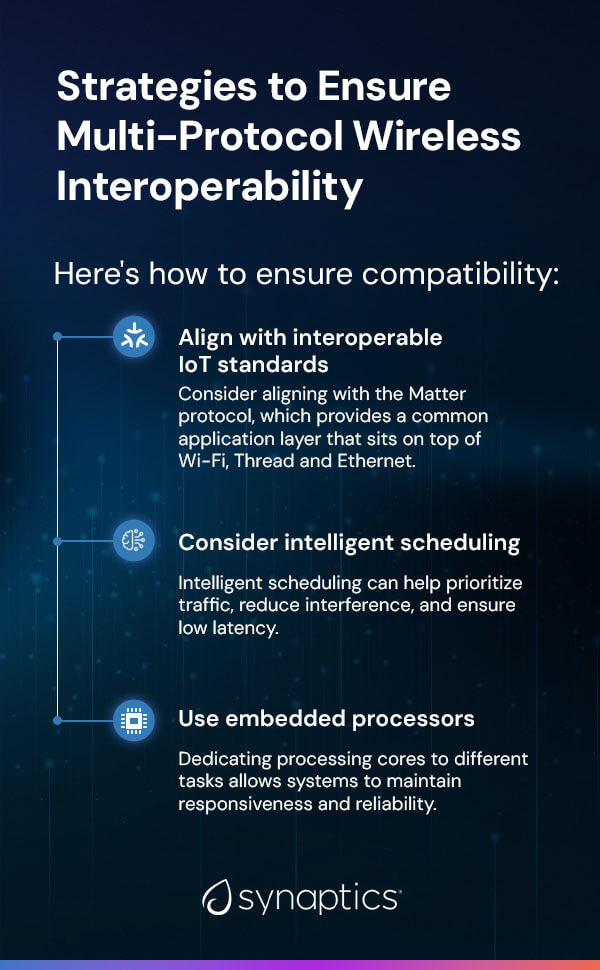The need for smart, wirelessly connected devices spans homes, offices and cities. As products evolve, so do the expectations of compatibility across ecosystems and platforms.
Supporting multiple untethered protocols is crucial for businesses building connected solutions. Whether you're integrating smart lighting or next-generation user interfaces, multi-protocol Internet of Things (IoT) interoperability ensures systems perform effectively.
Discover what multi-protocol interoperability is, why it matters and strategies to ascertain compatibility.
What Is Multi-Protocol Wireless Interoperability?
Multi-protocol wireless interoperability refers to a device's ability to communicate across multiple over-the-air communication standards without interference. It allows products to work cohesively when using different wireless protocols.
Smart home connectivity is a prime example. Products often rely on Wi-Fi for internet access, Bluetooth for nearby setup and Thread or Zigbee for local control. Interoperability ensures devices using diverse technologies can share data, respond to events and support use cases.
Different wireless technology serves distinct functions:
- Wi-Fi enables high-bandwidth cloud access
- Bluetooth supports low-power, short-range communication
- Ultra-wideband (UWB) enables precise location for access control
- Global navigation satellite system (GNSS) enables geolocation and tracking
- Zigbee and Thread deliver reliable mesh networking across smart home devices
Nine Benefits of Multi-Protocol Wireless Support
Multi-protocol interoperability facilitates product performance, ease of use and relevance. Explore the nine advantages of multi-technology compatibility below.
1. Improves User Experience
Devices that communicate across protocols remove barriers for users who expect technology to work regardless of the underlying technical framework.
An example is using a connected door lock. A user might set it up via Bluetooth on their phone, control it remotely over Wi-Fi and integrate it to home automation through Thread. If each connection required a different setup process, the experience would be frustrating.
When these protocols run effortlessly behind the scenes, the device becomes intuitive, responsive and cohesive.
2. Enables Wider Market Reach
Supporting multiple cable-free protocols expands a product's compatibility across platforms and use cases.
For example, Zigbee is widespread in home automation, and buyers might prioritize Wi-Fi for long-range, secure connectivity.
When a device can operate across several protocols, it becomes more adaptable. Manufacturers don't need to develop multiple SKUs or limit themselves to narrow ecosystems. A single product line can address a range of deployment scenarios.
3. Supports Matter Protocol Standards
The adoption of the Matter protocol is changing how smart devices are built, connected and maintained. Matter streamlines smart home connectivity by standardizing how products communicate regardless of brand or platform.
Matter builds on existing wireless protocols and relies on:
- Thread for low-power mesh communication
- Wi-Fi for high-throughput tasks
- Bluetooth for device onboarding
This means endpoints must still support and coordinate multiple protocols. A device that handles Wi-Fi, Thread and Bluetooth simultaneously and switches between them intelligently will integrate into Matter-certified ecosystems.
4. Reduces Costs and Complexity
Adding support for multiple protocols might sound like it would increase costs, but the opposite is often true when cross-platform connectivity is built into a shared architecture.
Instead of creating and managing separate hardware variants for each protocol, product teams design around a single chip or system-on-module (SoM) that accommodates the required standards.
5. Simplifies Data Exchange
In connected systems, data flows between devices, gateways, clouds and users. The information may come from different sources, each using different communication protocols. Interoperability ensures this information moves freely.
For instance, a health monitoring device might collect biometric data via Bluetooth, sync it through Wi-Fi to a cloud dashboard and trigger alerts on a caregiver's device via a local Zigbee hub. Without tight coordination between protocols, that information flow becomes delayed, interrupted or difficult to manage.
Cross-platform connectivity allows for systems to translate, forward and relay signals appropriately across networks.
6. Future-Proofs Products

A device that accommodates multiple protocols can adapt to:
- Changes in infrastructure
- Ecosystem shifts
- Regional or industry-specific requirements
By selecting chipsets and solutions that support protocol updates and offer firmware updates, manufacturers reduce the need for hardware redesigns down the line. This approach protects the product's lifespan and helps companies stay competitive when interconnection standards shift.
7. Enhances Flexibility and Integration
Multi-protocol support facilitates thoughtful system design. Instead of being locked into a single connectivity model, designers choose the right tool for each part of the experience.
For example, a smart appliance might use Wi-Fi for remote control and cloud updates, Bluetooth for local maintenance and Thread for energy-efficient automation.
Matching each function with the most suitable protocol allows manufacturers to optimize performance, battery life and user satisfaction.
8. Streamlines Cross-Platform Connectivity
Multi-protocol support enables products to work across different platforms and ecosystems such as Apple HomeKit, Google Home, Amazon Alexa and Samsung SmartThings. Consumers expect this level of connectivity in the smart home space because they often use devices from different brands.
Protocols like Thread, Wi-Fi and Matter make it easier for devices to integrate across ecosystems. When devices are compatible at the hardware and software levels, this compatibility reduces onboarding friction and positions products to scale across new markets.
9. Ensures Regulatory Compliance
From radio spectrum usage to data privacy and transmission standards, multi-protocol products must operate within required frameworks to be certified for sale and use.
Regulatory bodies have distinct requirements for how wireless radios operate, coexist and interact with other networks. Coexistence and adherence to frequency and power thresholds help meet these standards.
Interoperable devices built with certified, untethered components meet these requirements, accelerating time-to-market and reducing costly redesigns.
Challenges of Multi-Protocol Integration
While multi-protocol wireless interoperability has appealing benefits, it poses challenges that require careful design and infrastructure to manage effectively.
Security
When devices operate across multiple untethered protocols, they expose different types of data to different networks. Bluetooth and Wi-FI have distinct authentication mechanisms and encryption requirements. Thread and Zigbee introduce mesh routing, where multiple products pass information across a network, creating additional entry points if not secured properly.
To support more secure systems, some manufacturers embed security into the silicon level by integrating hardware-based encryption, secure key storage and authenticated firmware execution. This approach reduces the risk of fragmented or inconsistent protection across wireless interfaces.
Power Management
Power efficiency may be hard to maintain when multiple radios are active. Each protocol has different power requirements. Wi-Fi, while fast, draws more energy than Thread. Products that switch between protocols or use several technologies simultaneously can experience battery drain. This inefficiency may impact battery-powered devices like wearables, home sensors and mobile equipment. If designers don't balance performance with power usage, the device may not meet real-world expectations.
One way to address this is through dynamic power allocation, where embedded processors monitor workload and adjust to balance performance and energy consumption. Embedded processors enable dynamic resource allocation, optimizing energy use based on current protocol needs.
Data Management
Multiple protocols have different formats and transmission intervals, making managing that information at the edge a challenge. Some protocols are built for high-bandwidth data, while others deliver smaller, frequent updates. When these streams converge on a single device or cloud solution, they need to be processed and forwarded correctly.

Streamlined processing requires a system that prioritizes data, manages bandwidth and handles protocol-specific tasks without losing consistency. Embedded processors and edge artificial intelligence (AI) systems reduce the load on centralized infrastructure.
Scalability
Supporting multiple protocols across a growing device fleet requires a scalable architecture. This means managing firmware updates across different stacks, maintaining compatibility across device versions and ensuring performance holds up as the system expands.
What works well with 10 devices in a lab might not scale to thousands of units in a smart city deployment. Protocol bottlenecks, memory constraints and inconsistent behavior across firmware versions become pain points if not planned for.
Privacy and Compliance
New standards are constantly emerging, and regions and industries have differing compliance requirements. These factors add friction to long-term support and regulatory approval. From a privacy perspective, companies must ensure that information collected via one protocol isn't exposed or handled differently when transferred across another.
Regulatory frameworks often require auditable consistency in how data is handled and protected. Manufacturers need the flexibility to adapt to these changes, such as through over-the-air (OTA) updates, modular firmware stacks or platforms that can support new protocols.
Coexistence and Interference
Most wireless protocols operate in overlapping frequency bands. Wi-Fi and Bluetooth use the 2.4 gigahertz (GHz) spectrum, which leads to congestion, cross-talk and dropped connections if not managed properly. In some settings, devices must constantly share spectrum with other products, sometimes with competing demands for bandwidth or low latency.
Designing for wireless coexistence without degrading performance is essential. For example, managing Zigbee and Thread interoperability is crucial when a smart lighting system needs to work with a security hub operating on a different mesh standard.
An effective strategy is using hardware and software that manage how radios operate and transmit information. Some system-on-chip (SoC) devices have coexistence features that reduce interference between protocols. These systems apply intelligent scheduling and isolation to manage traffic across radios, enabling concurrent connections that maintain performance.
Strategies to Ensure Multi-Protocol Wireless Interoperability

Integrating multiple over-the-air protocols requires systems and tools that focus on coordination across protocols, record handling, security and device behavior. Here's how to ensure compatibility:
- Align with interoperable IoT standards: Protocols like Bluetooth, Wi-Fi and Thread have established ecosystems, support from large industry alliances and common certification processes, which increase compatibility. Consider aligning with the Matter protocol, which provides a common application layer that sits on top of Wi-Fi, Thread and Ethernet and simplifies integration across ecosystems and brands.
- Consider intelligent scheduling: Intelligent scheduling helps to prioritize traffic, reduce interference, and ensure low latency. Wireless SoCs incorporate scheduling mechanisms into the chip architecture, allowing for adaptive timing, task prioritization and low-latency transitions between protocols.
- Use embedded processors: Dedicating processing cores to different tasks allows systems to maintain responsiveness and reliability. For example, AI-native IoT processors offer real-time stack management and secure resource allocation in one package. These processors can handle audio, vision, voice and touch without burdening the main processor.
Four Best Practices for Multi-Protocol Wireless Interoperability
Designing for multi-protocol wireless compatibility necessitates making informed decisions throughout the development process. Here are four best practices to help teams build smarter, more-flexible systems that perform reliably.
1. Evaluate Protocol Requirements
Before you explore product design, take time to understand how the device will be used and which protocols are most appropriate for each function. Wi-Fi may be essential for cloud access, but Bluetooth might be better for local pairing. Zigbee or Thread could suit low-power mesh networks. Rather than defaulting to a single protocol, map out integration needs by setup, control and location. This step helps ensure that each part of the system is efficient.
2. Prioritize Coexistence and Power Management
If your product uses multiple protocols, it's essential to think about how they'll interact. Planning for coexistence helps to avoid performance issues. Similarly, efficient power management strategies extend battery life and reduce thermal strain in portable or always-on devices.
Look for platforms that support concurrent protocol operation and dynamic power allocation to make this easier to manage within your system design.
3. Select Standards-Aligned Upgradable Platforms
Choosing chipsets or SoCs that align with industry standards makes it easier to build interoperable systems that integrate with third-party devices, ecosystems and hubs. Look for vendors who offer long-term support, regular firmware updates and compatibility with emerging protocols. Future-proofing may minimize the costs and effort required to update products. Solutions that allow for over-the-air updates or modular firmware stacks provide flexibility with minimal hardware redesigns.
4. Test for Interoperability
Teams may discover compatibility issues after integration has started. When businesses test for interoperability across protocols, ecosystems and products from the early prototype stage, they catch potential issues when they're easier to address. This process may involve checking that devices are connected and verifying that they:
- Maintain stable connections
- Behave consistently
- Respond appropriately across different settings and user scenarios
Where possible, work with third-party certification bodies or ecosystem alliances to validate compatibility.
Deliver Smart Wireless Connected Systems With Synaptics
Synaptics helps businesses bring smarter, more responsive products to market. We provide embedded edge AI processors, wireless multi-protocol IoT connectivity solutions, multimedia SoCs and human interface technologies. Our technologies are secure and power-efficient and can personalize home, mobile and enterprise devices.
We provide tools to connect multi-protocol communication and a unified user interface within a single design. Our team offers technical support to simplify integration.
Contact us today to get started.


